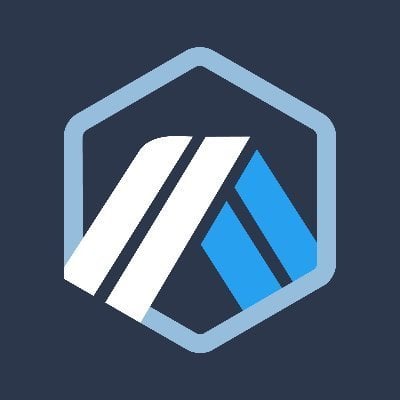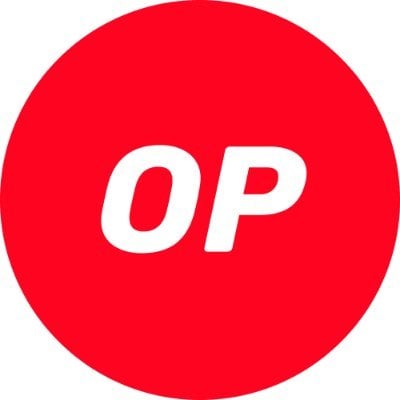Layout Cancun upgrade, who is the better choice, OP or ARB?
Author: Alex Xu, Mint Ventures
In 2023, the Cancun upgrade is undoubtedly one of the most critical industry events following the Shanghai upgrade, and the L2 projects benefiting from it are also the key tracks we are focusing on this year.
According to current news, the Cancun upgrade included in EIP4844 is expected to take place between 2023.10 and 2024.1. The token prices of the two main L2 projects, Arbitrum (hereafter referred to as ARB) and Optimism (hereafter referred to as OP), have experienced significant corrections after reaching new highs in the first half of the year, and it may still be a good time to position.
Of course, from a market capitalization perspective, OP's circulating market cap has been hitting new highs since entering 2023, while ARB has been consolidating at lower levels. The author attempts to clarify the following in this article:
- The sources of value and business models of L2
- Comparison of competitiveness and business data between OP and ARB
- How the Cancun upgrade significantly improves the fundamentals of L2
- Potential risks of OP
The content of this article reflects the author's views as of the time of publication, with more emphasis on business evaluations and less on the technical details of L2. This article may contain factual errors, opinions, and biases, and is intended for discussion purposes only. Corrections from other investment research peers are also welcomed.
1. Sources of Value and Business Models of L2
1.1 Sources of Value and Moats of L2
L2 provides products similar to those offered by L1, namely: stable, censorship-resistant, and open blockchain space, which we can also view as a specialized form of on-chain cloud service. Compared to L1, the main advantage of L2 blockchain space is its lower cost. Taking OP as an example, its average gas cost is only 1.56% of Ethereum's.
Because blockchain space is a specialized cloud service, this also means that the demand it meets is not universal; most internet services do not need to operate on L1 or L2. However, in the traditional world, where constraints are numerous and transparency is lacking, financial services have the richest application practices on the blockchain.
The demand for L2 blockchain space from service builders and users determines the upper limit of L2's value.
Like L1, L2 can build a moat based on network effects.
On L2, the larger and more diverse the user base, the easier it becomes for people to collaborate on L2, and new service models can more easily sprout here, further satisfying and attracting users into this network. Each new user entering and residing on the L2 network increases the potential value of this L2 network to other users.
In the Web3 world, the strength of network effects for L1 & L2 is second only to stablecoins represented by USDT. The more prominent the L1 & L2, the higher the barriers, and thus they often enjoy higher valuation premiums.
1.2 Profit Model of L2
The profit model of L2 is clear and simple: on one hand, it purchases storage space from a trusted DA (Data Availability) layer to back up its L2 data (so that when issues arise in L2 operations, it can restore using the backup data); on the other hand, it provides users with cheaper blockchain space services and charges accordingly. Its profit comes from: L2 fees (base fees + MEV income) - costs paid to DA service providers.
Taking OP and ARB as examples, their chosen DA layer is Ethereum, the most decentralized and trustworthy L1, where they pay gas fees to store their compressed L2 data. The fees they charge come from the gas paid by users (including regular users and developers) when using their L2, and the MEV income, with the latter minus the former being their gross profit.
It is referred to as gross profit because this portion of profit has not yet deducted other project expenses, such as labor costs, ecosystem rewards, marketing expenses, etc.
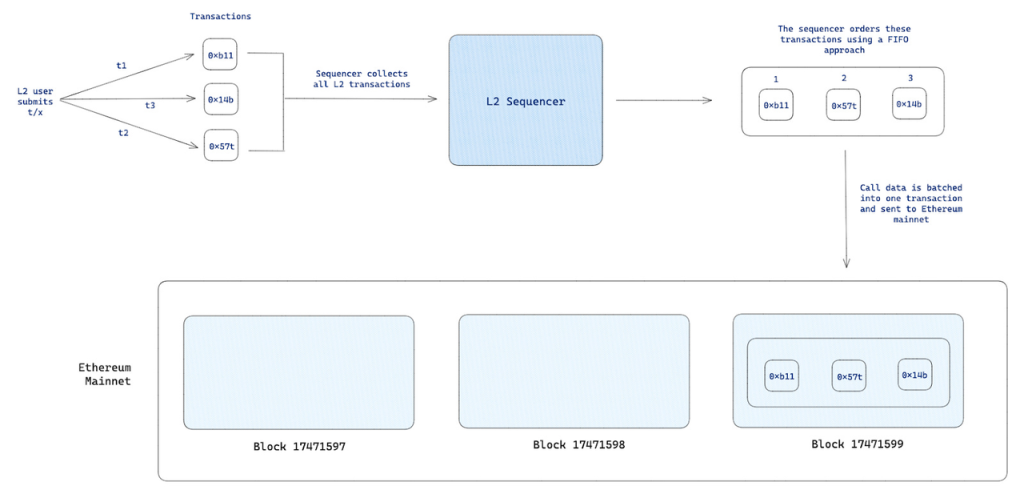 The role of sequencers in the L2 business process
The role of sequencers in the L2 business process
The fee collection of L2 and the cost payments of L1 are executed by L2's sequencer, and the profits also belong to the sequencer. Currently, both OP and ARB's sequencers are operated by the official team, and profits go to the official treasury. Of course, centralized sequencers mean extremely high single-point risks, and both OP and ARB have long-term commitments to decentralize their sequencers.
The mechanism of decentralized sequencers is likely to operate under a POS mechanism, where decentralized sequencers need to stake L2's native tokens like ARB or OP as collateral. When they fail to fulfill their duties, the collateral will be slashed. Regular users can stake themselves as sequencers or use staking services provided by entities like Lido, where users provide collateral tokens, and professional, decentralized sequencer operators execute the sequencing and uploading services, while staked users can share most of the L2 fees and MEV rewards obtained by the sequencers (under Lido's mechanism, it's 90%).
At that time, ARB and OP tokens will gain economic value empowerment beyond mere governance.
1.3 ARB VS OP
Competitive Advantages of OP
Since its launch, ARB has consistently outperformed OP in various L2 business data. According to the previously mentioned L2 network effects, ARB, as a leading L2, has stronger competitiveness than OP and should enjoy a higher valuation premium.
However, this began to change gradually after OP proposed the Superchain strategy in February this year and started to promote the OP stack.
The OP stack is an open-source L2 technology stack, meaning that other projects wishing to run L2 can use it for free to quickly deploy their own L2, significantly reducing development and testing costs. Superchain is the future blueprint envisioned by OP, where L2s adopting the OP stack can achieve secure, efficient, and atomic-level communication and interaction of information and assets with each other due to architectural consistency, similar to Cosmos's "Interchain," which is referred to as Superchain.
After the launch of the OP stack and Superchain, it was first adopted by Coinbase, which announced its L2 Base built with the OP stack along with the Superchain strategy in February, and it officially went live on August 10. With Coinbase's demonstration effect, the OP stack has gained adoption from more and more projects, such as Binance's opBNB, NFT project ZORA backed by Paradigm, the Loot ecosystem project Adventure Gold DAO, the public goods service project Public Goods Network (PGN) supported by Gitcoin, leading options project Lyra, and the well-known on-chain data dashboard Debank, even the original L1 Celo has chosen the OP stack as its L2 solution.
Previously, L2 projects served users utilizing their own blockchain space, while Superchain and the OP stack have expanded the definition of users to include L2 operators, transforming from a 2C (where L2 developers are also defined as C) business into a 2B2C business, which has built new sources of value and moats for OP:
- Multi-chain network effects. The definition of "network" in network effects is expanded from single-chain to "multi-chain network," where multi-chains link funds and information across chains through the standardized OP stack, with L2 operators responsible for user acquisition and operations, increasing the total user population of the "multi-chain network." The increase in the total population of the multi-chain network also enhances the value of each user and each L2 within the network.
- Scale effects. Fixed technical infrastructure costs (such as upgrades and maintenance of the OP stack) are borne by OP, but feedback and improvements provided by other users of the OP stack further enhance the quality of the OP stack, reducing the costs of technical maintenance and upgrades, sequencer, and indexing incentives for single chains, thus increasing the attractiveness to potential L2 solution adopters.
- Community of interests. Bringing more Web3 industry giants into the OP ecosystem, due to the alignment of interests, makes it easier to gain their support in technology, users, developers, investments, and other aspects.
From a single-chain ecosystem to an interconnected chain ecosystem, OP not only benefits from the expected growth in the total number of users and developers across chains, but its main business data on the OP main chain has also been continuously catching up or even surpassing the previously leading ARB, such as:
a. Monthly active addresses: The weekly active addresses of OP/ARB have risen from a low of 32.1% to the current 73.6%.
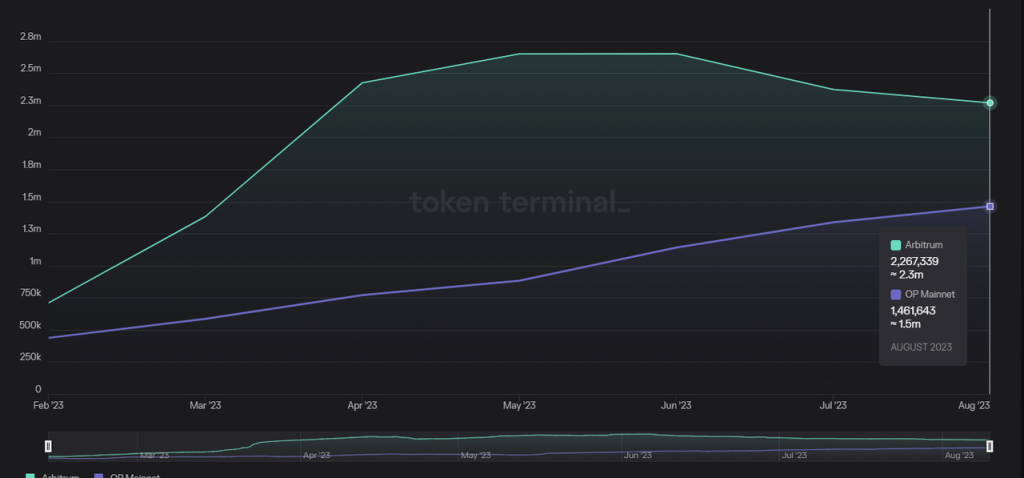 Data source: tokenterminal
Data source: tokenterminal
b. Monthly L2 profit: The L2 profit of OP/ARB has risen from a low of 16.4% to the current 100.2% (surpassing).**
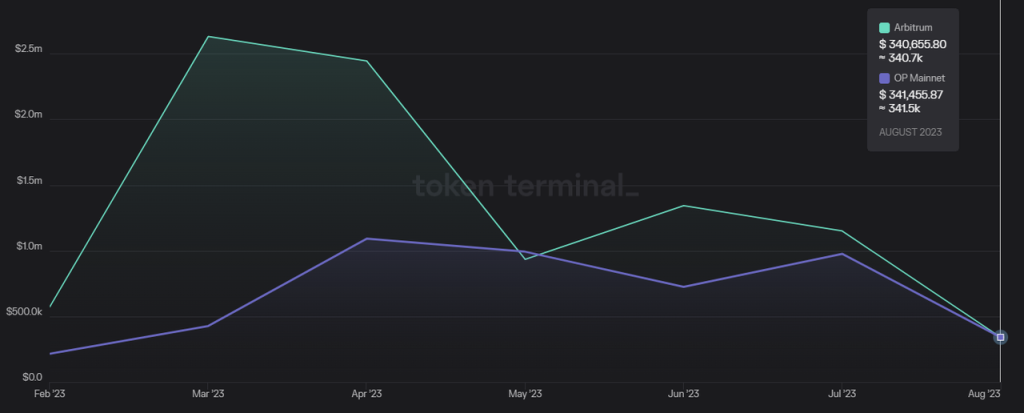 Data source: tokenterminal
Data source: tokenterminal
c. Monthly interaction counts: The monthly interaction counts of OP/ARB have risen from a low of 22.4% to the current 106.5% (surpassing).**
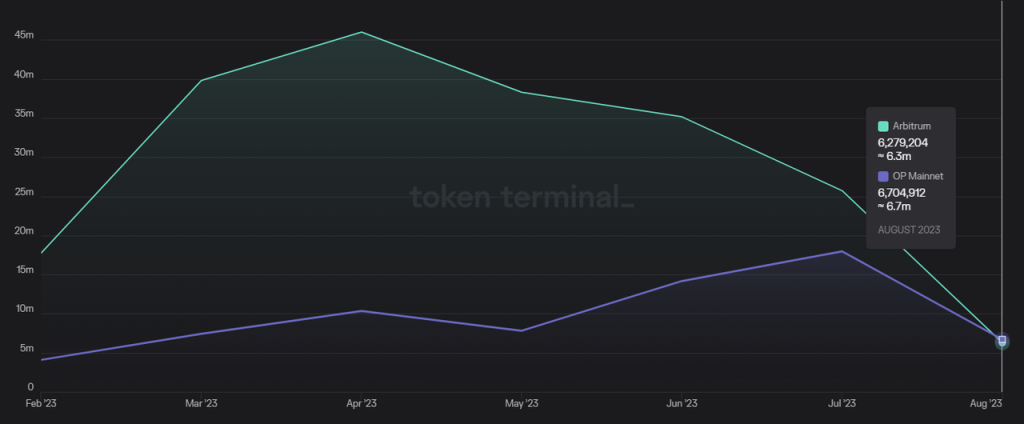 Data source: tokenterminal
Data source: tokenterminal
d. On-chain capital volume: The on-chain TVL of OP/ARB has risen from a low of 1/3 to the current 1/2.
The on-chain TVL of OP was around 2 billion in March and is currently around 3 billion.
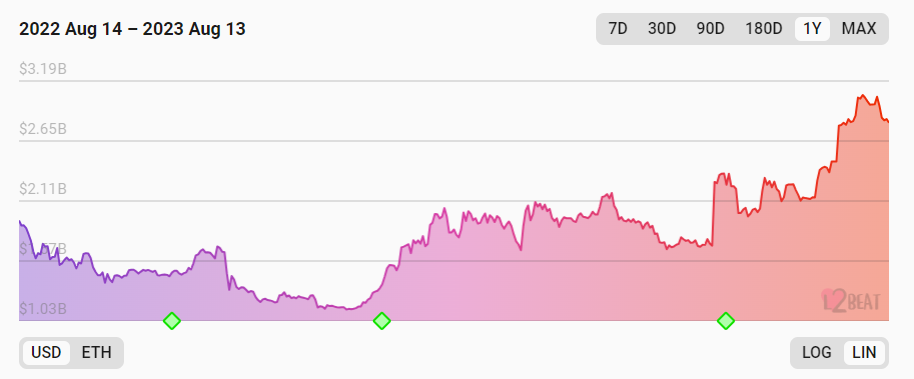
The on-chain TVL of ARB was around 6 billion in March (peaking at 7 billion) and is still around 6 billion.
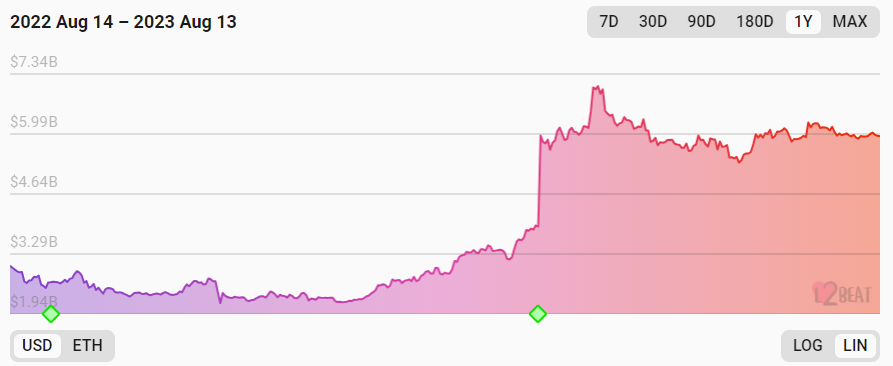 Data source: https://l2beat.com/
Data source: https://l2beat.com/
Valuation Comparison of OP and ARB
Corresponding to OP's rapidly rising business data, the valuation of the OP main chain relative to ARB is becoming increasingly attractive.
P/E (Market Cap / Annualized Profit of L2): Based on the revenue from the past week, OP's PE has fallen below 80, while ARB is at 113. This has been achieved even as OP's price has been significantly strong in recent months, with circulating supply continuously unlocking and increasing.
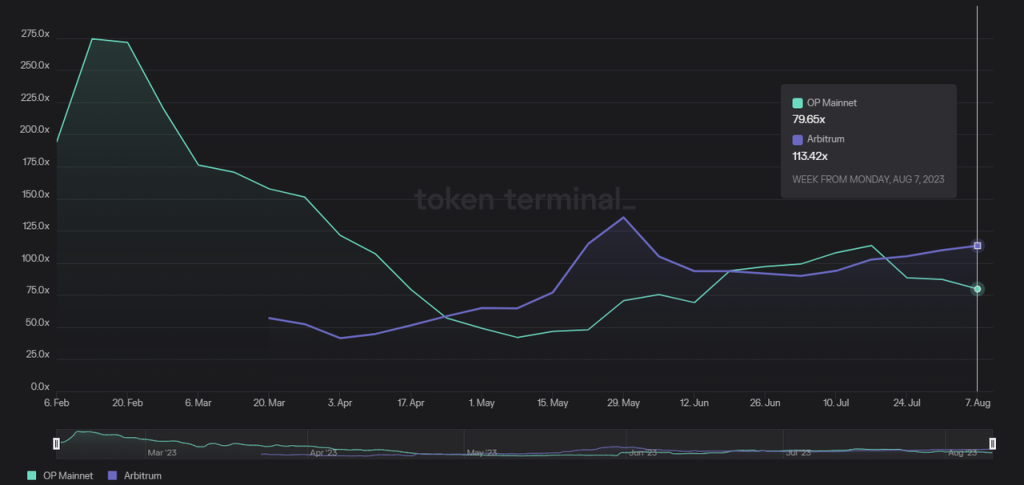 Data source: tokenterminal
Data source: tokenterminal
Rapid Development of New Forces in the OP Ecosystem
The continuous catch-up of OP's main chain business data relative to ARB is influenced by the recovery of its own ecosystem, but the contribution from new business partners joining the OP camp is even greater. For example, in the past 30 days, the projects contributing the most transaction counts on the OP main chain include Gnosis Safe contract operations ranking first and Worldcoin ranking fourth.
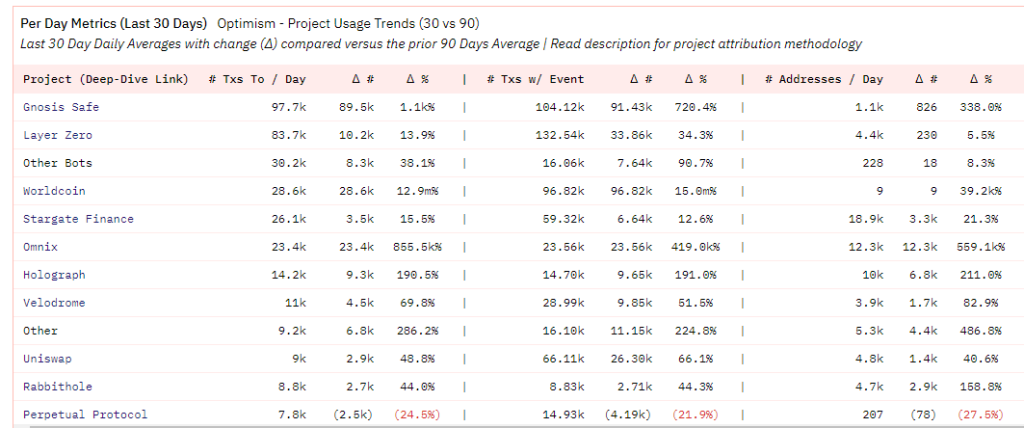 Data source: https://dune.com/optimismfnd/Optimism
Data source: https://dune.com/optimismfnd/Optimism
In fact, a large number of transactions on Gnosis Safe are also contributed by the Worldcoin team. As early as the end of June this year, World App had already deployed over 300,000 Gnosis Safe accounts, which was caused by the migration of World App accounts to the Optimism mainnet.
According to Worldcoin's official data on August 11, its registered users have exceeded 2.2 million, creating 257,000 new accounts in the past 7 days, with an average daily transaction count of 126,000, accounting for about 21% of the current daily transaction counts on OP and ARB mainnets.
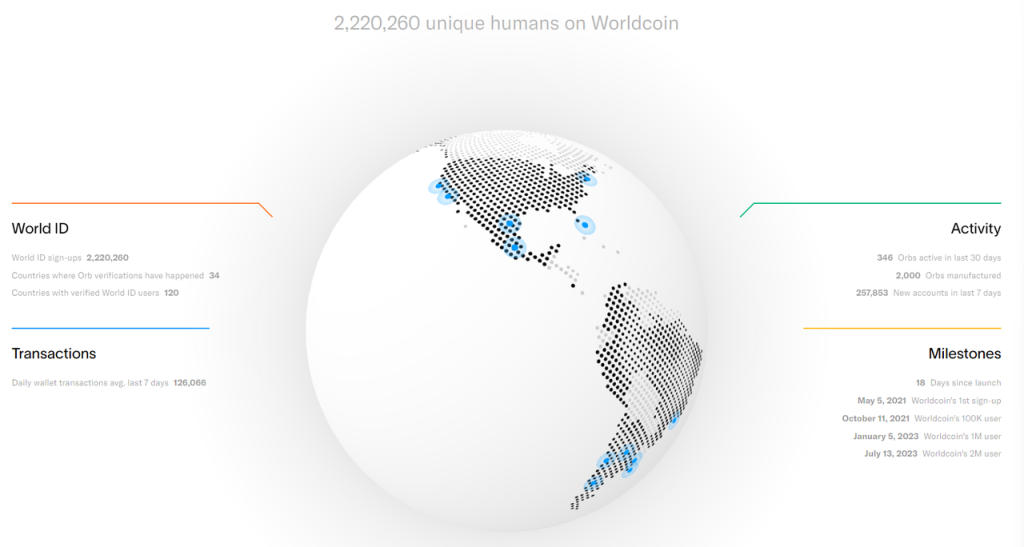 Data source: https://worldcoin.org/
Data source: https://worldcoin.org/
Currently, Worldcoin has only migrated its ID system and tokens to the mainnet, and will subsequently develop application chains based on the OP stack, which is expected to bring more active users and developers.
In addition to Worldcoin's contribution to the OP mainnet, the data growth of Base L2, the first and largest supporter of OP stack, after its launch is also very strong, with its active address count reaching 136,000 on August 10, just a step away from ARB's 147,000, the top L2.
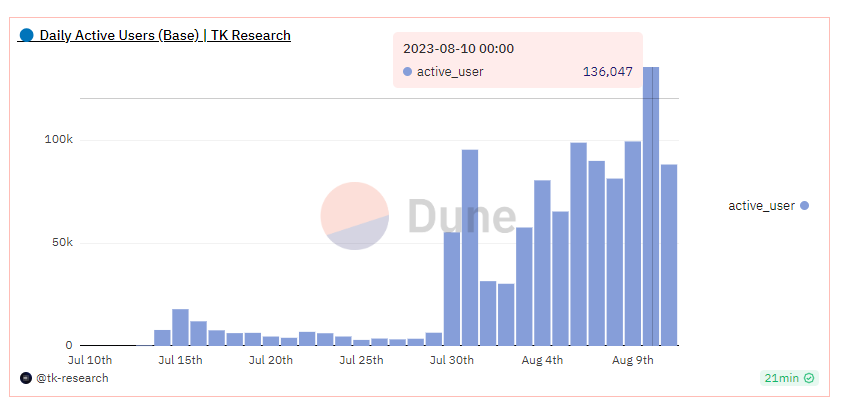 Data source: https://dune.com/tk-research/base
Data source: https://dune.com/tk-research/base
Among all smart contract L1 & L2, this data ranks only behind Tron (1.5M), BNBchain (1.04M), Polygon (0.37M), and Arbitrum (0.14M). Furthermore, the first application that became popular after the official launch of Base on August 10 was not the traditional DeFi or Meme applications, but a social application called friend.tech, which is even more surprising.
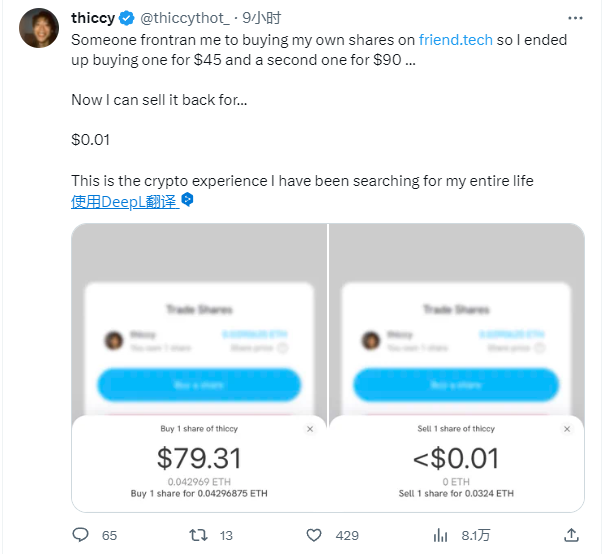
The Dilemma of ARB
The dilemma for ARB is that, although it has Arbitrum One, a strong L2 main chain with robust business data, and the higher-performing Arbitrum Nova, it has also launched the Orbiter L3 stack to compete with the OP stack. However, during the burgeoning phase of L2, there are not many large projects willing to define themselves as L3 and use Arbitrum One as their DA layer. Projects with better industry resources (users, developers, IP content) tend to prefer building L2, which means a higher valuation ceiling and broader user targeting.
In the market for smaller Rollup projects, Arbitrum's Orbiter also faces competition from RaaS (Rollup as a Service) projects represented by ALTLayer. ALTLayer provides low-threshold, low-code rollup construction and operation solutions, helping users integrate various modules of rollups available in the market, allowing users to assemble combinations like building with Legos.
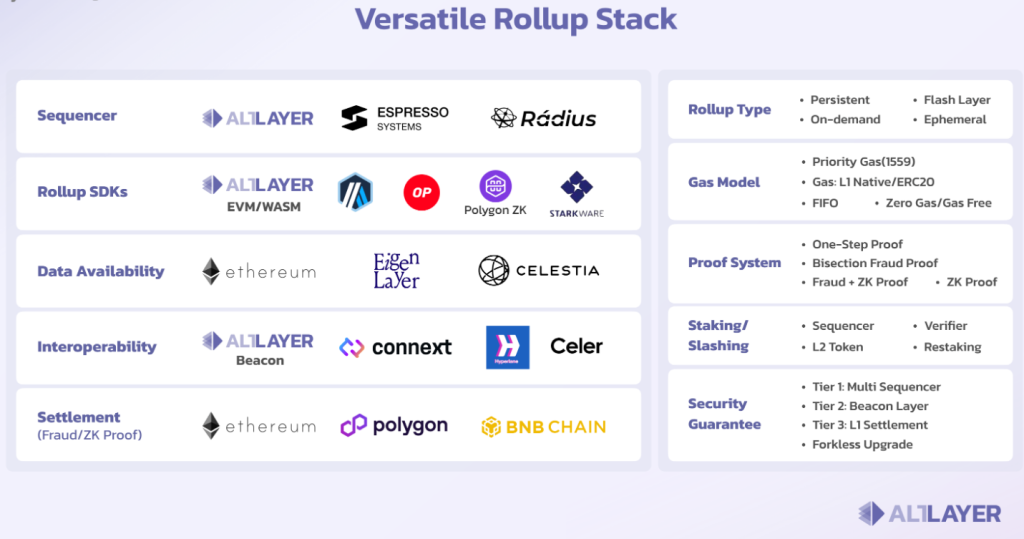 Modular solutions provided by ALTLayer
Modular solutions provided by ALTLayer
In the rollup menu provided by RaaS projects, Arbitrum's Orbiter is just one of the optional solutions. Smaller users may also choose a more economical L2 solution after comparing options, rather than defining themselves as L3.
In this situation, although Arbitrum One maintains a slight lead in business data compared to other L2s, its user share in the entire L2 market is actually rapidly declining, as a large number of new and old users are flowing to the OP ecosystem and hybrid L2s.
Overall, OP, through its open-source L2 suite, introduces network effects formed by the users of its partners in a B2B2C model, which has a clear commercial advantage over Arbitrum's strong single-chain approach in the long run. If ARB does not adjust its strategy moving forward, its position as the L2 single-chain king may be at risk.
2. How the Cancun Upgrade Improves the Fundamentals of L2 Projects
2.1 Current Project Valuation Estimates for ARB and OP
We estimate the valuation levels of ARB and OP based on their revenue data over the past three months and current prices.
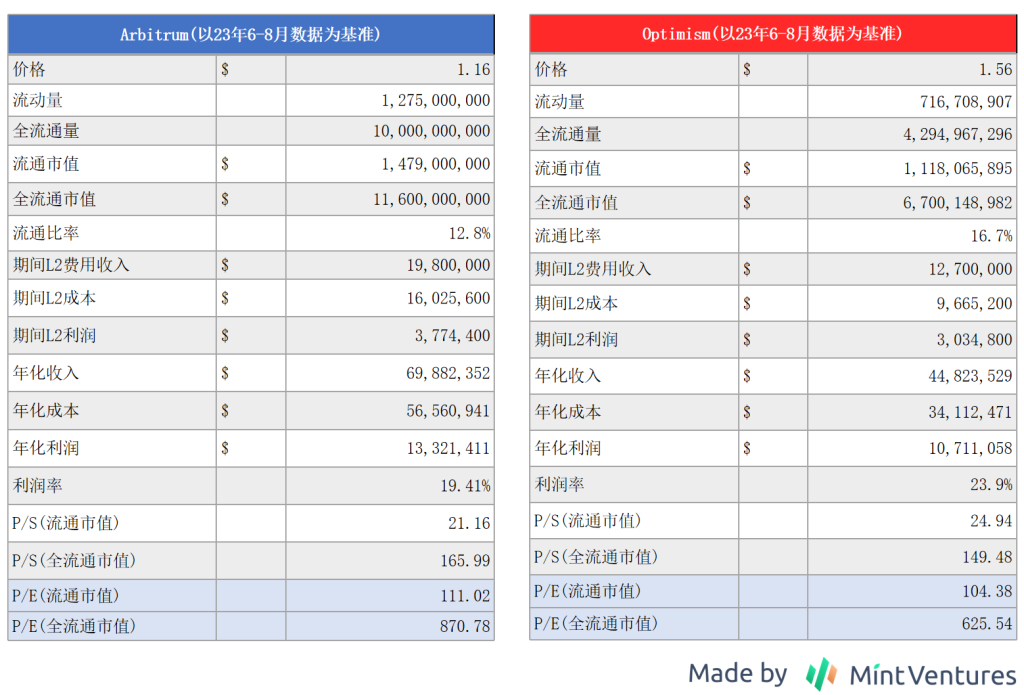
If we assume that the P/E ratio remains unchanged, and that the L1 costs for ARB and OP decrease by 90% after the Cancun upgrade (EIP 4844 is expected to reduce L1 costs for L2 by 90-99%, here we take a conservative value, see references for details), while the L2 fee structure remains unchanged, the projected prices for ARB and OP are as follows:
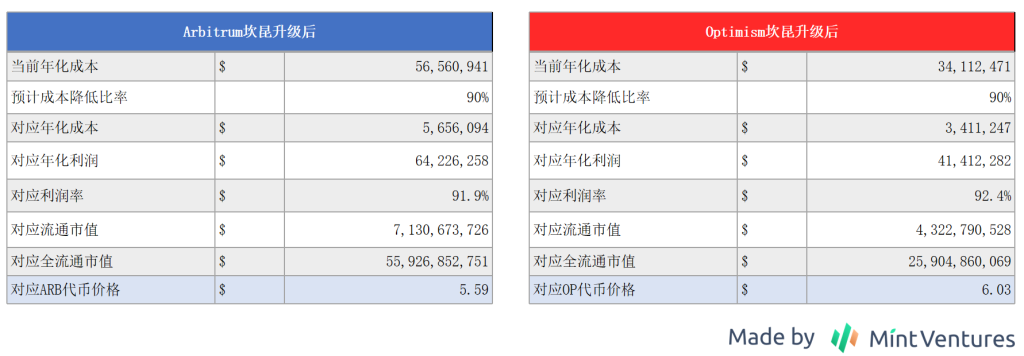
The reduction in L1 cost expenditures brought about by the Cancun upgrade directly impacts profit increases, corresponding to valuation improvements.
2.2 Impact of the Cancun Upgrade on L2 Valuations
Of course, with the decrease in L1 costs after the Cancun upgrade, both ARB and OP will have to lower their corresponding L2 fees. Therefore, when estimating valuations, we also need to consider two variable factors:
- What percentage of cost reductions ARB and OP will pass on to users in the form of lower L2 fees.
- How much of an increase in L2 transaction activity will result from the reduction in L2 fees.
Based on the premise of unchanged P/E multiples, the author extrapolates the token prices of ARB and OP after the Cancun upgrade based on the changes in the "ratio of cost reductions converted to fee reductions" and "the increase in transaction counts resulting from fee reductions":
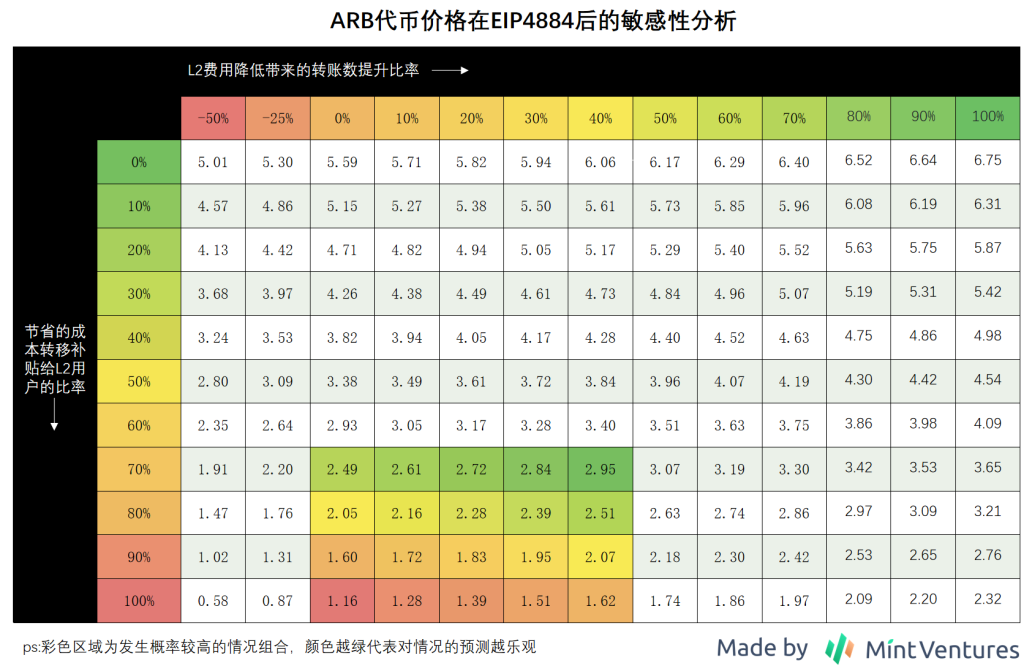
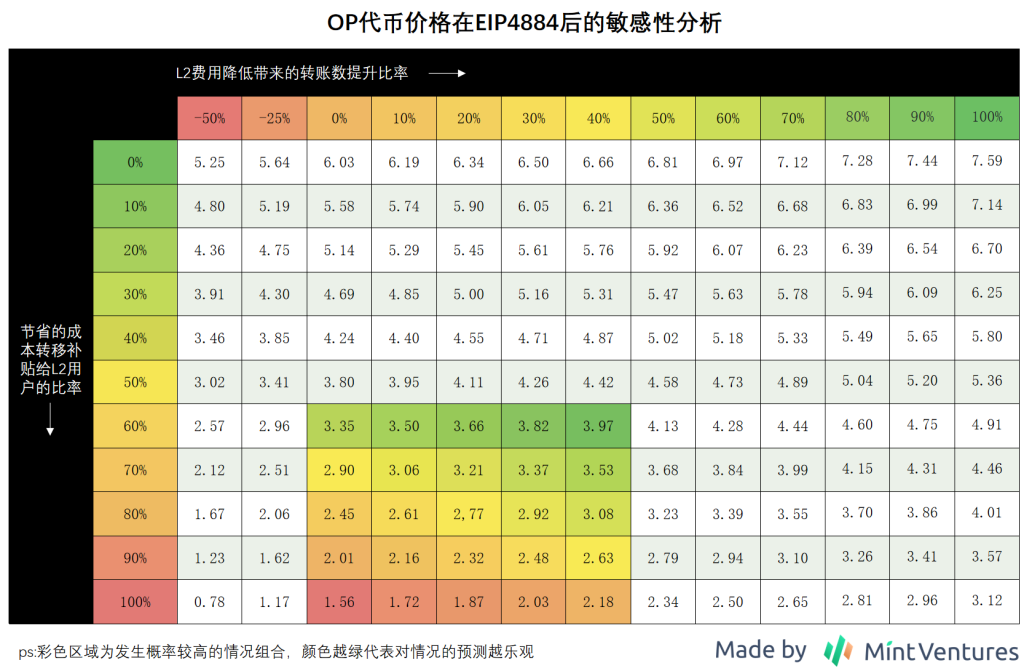
The core logic of the above two token price estimation tables is:
- The lower the percentage of cost reductions that L2s pass on to users, the higher their operational profits.
- The higher the increase in transaction activity resulting from L2s lowering fees, the higher their operational profits.
Additionally, since OP's current gas fees are approximately 30-50% lower than ARB's, OP has a greater margin for retaining savings as L1 costs decrease. Therefore, the author believes that OP's space to transfer savings to users is between 60-100%, while ARB's is 70-100%.
Just from the impact of the Cancun upgrade on OP and ARB single chains, the potential for price increases for OP and ARB at current prices is relatively similar.
Of course, the above analysis of the price sensitivity of ARB and OP after the Cancun upgrade is somewhat mechanical, and the factors not considered in this estimation include at least:
- The above estimation is based on the current project PE, which already incorporates expectations for the Cancun upgrade.
- When the Cancun upgrade arrives, OP will have more token emissions compared to now, and under the assumption of unchanged estimated market cap, the token price should be lower.
However, the unchanging logic is that the higher the operational profits of L2, the higher its intrinsic value, making it easier to obtain higher market valuations. The Cancun upgrade can bring significant marginal improvements to L2 projects in terms of cost savings and increased on-chain activity.
3. Potential Risks of OP
As mentioned above, OP relies on the narrative of Superchain and the widespread adoption of the OP stack to elevate from a single-chain L2 to an interconnected L2 ecosystem, introducing more ecosystem population through the B2B2C model based on partners of the OP stack. In the long run, this has stronger network effects, scale effects, and allies with shared interests, making it a better commercial form than ARB. Additionally, the main business data of the OP mainnet has been continuously catching up or even surpassing ARB in recent months, and other OP stack L2s like BASE are also rapidly developing, further squeezing ARB's market share.
Considering that the token price appreciation expectations for ARB and OP, benefiting from the Cancun upgrade, are similar, OP, with the backing of the Superchain narrative, currently appears to be a better investment target.
However, the competition in the L2 track remains fierce, and the author believes that the following risks for OP need to be monitored:
3.1 ARB chooses to open its L2 permissions, adopting a similar approach to OP to compete for the total network population of L2
Currently, Arbitrum still uses a Business Source License (BSL), and other partners wishing to use the Arbitrum stack to build a Rollup ecosystem need to obtain formal authorization from the Arbitrum DAO or Offchain Labs (the development company of Arbitrum), or develop L3 based on Arbitrum One. However, with the rapid expansion of the OP stack and the significant increase in network population over the past few months, the Arbitrum community is starting to feel restless. On August 8, a member of the ARB team, stonecoldpat, posted a discussion in the governance forum, hoping the community could participate in discussions about "the conditions and timing for Arbitrum to issue code usage licenses to partners." The specific discussion topics include:
- Understanding the community's attitude towards issuing Arbitrum code usage licenses to other partners.
- Discussing whether additional conditions should be attached to the code authorization license.
- How to establish an evaluation mechanism to decide whether to issue licenses to others.
- A short-term and medium-term roadmap for the above content.
In the short term, determine which qualified partners can be issued licenses.
In the medium term, clarify the standards so that any partner meeting the criteria can obtain a license.
The discussion post also summarized the feedback the official team has received on this topic, mentioning:
"The Arbitrum Foundation or Offchain Labs has not yet issued licenses for the Arbitrum software stack to large strategic partners, which seems to be a strategic mistake. This hesitation may actually harm the Arbitrum ecosystem."
"We have not received any feedback suggesting that the Arbitrum Foundation should not issue licenses for the Arbitrum technology stack to strategic partners. Most concerns are about the standards for issuing licenses and the conditions that should be attached, allowing the DAO to provide preliminary opinions on the process."
Based on the above situation, the trend of Arbitrum's future strategy becoming more OP-like is already set in stone, and it will soon join the competition in the "L2 interconnected chain" market. This will inevitably pose a threat to the current flourishing form of the OP stack.
On August 9, Andre Cronje, co-founder and architect of the Fantom Foundation, stated in an interview with The Block that they are considering the Optimism L2 solution, examining both the OP stack and the Arbitrum stack. In the author's view, Fantom, as a once-leading L1, is unlikely to consider operating as Arbitrum's L3; what AC refers to as the "Arbitrum stack" should be an L2 solution.
But the question is, how long will it take for the Arbitrum community to reach a consensus with partners before licenses start being issued, and how many core customers will still be available to compete for by then? The longer this process takes, the more collaborators will join the OP stack ecosystem, which will be increasingly unfavorable for ARB.
3.2 Overall intensification of competition in the L2 service market
In addition to ARB and OP, ZK-based L2s are also rapidly developing or waiting to go live, with impressive business data (despite significant bubbles due to airdrop hunters) such as ZKsync, Linea backed by Consensys (with MetaMask having 30 million monthly active users and Infura having over 400,000 developers), and the highly anticipated Scroll, among others. Additionally, platforms like Altlayer, representing Rollup as a Service, provide extremely low-threshold modular assembly and operation services for Rollup developers and operators, directly entering the upstream of the OP stack, which will also squeeze OP's bargaining power within its ecosystem.
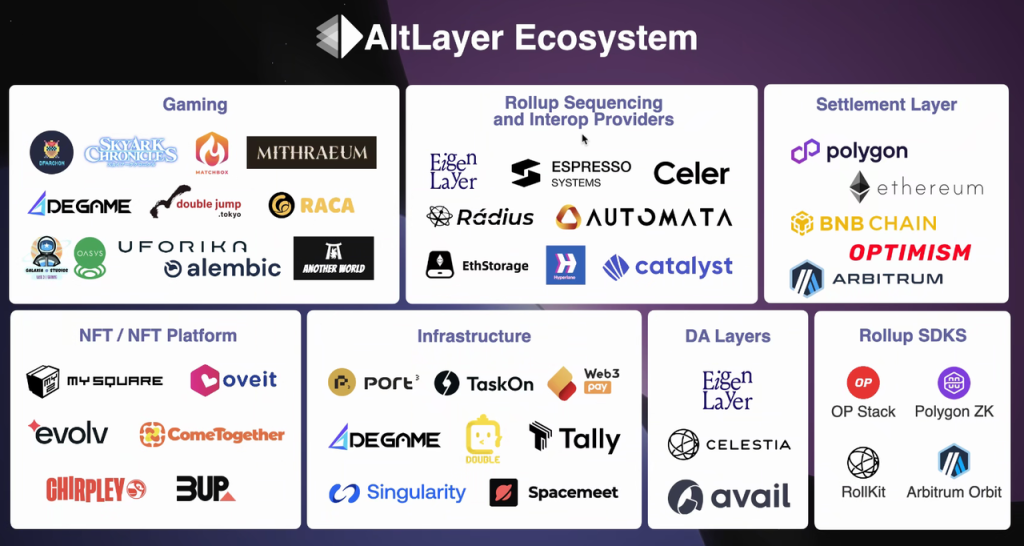 Products and customer ecosystem of Altlayer
Products and customer ecosystem of Altlayer
3.3 Development of the overall Superchain ecosystem, and whether value can be transmitted to the OP Foundation and OP tokens
Currently, OP tokens still lack direct value capture mechanisms, and among the many adopters of the OP stack, only BASE has explicitly committed to donating 10% of its L2 profits to the OP Foundation, while other collaborative projects have not yet made similar commitments. The validation of OP token value capture may have to wait until the formal launch of its decentralized sequencer protocol, observing the acceptance level of various OP stacks. If everyone can support and adopt a decentralized sequencer system using OP as collateral, it will inevitably create direct demand for OP, completing value transmission. However, if each L2 continues to implement its own sequencer standards or operates its own node systems, it will not only prevent OP from capturing value but also weaken the synergistic effects between L2s within the OP ecosystem.
3.4 Valuation risks
As mentioned in the previous section on OP's valuation, the author's calculations regarding the price increase of OP due to the Cancun upgrade are based on the premise that "the PE of OP L2 remains consistent after the upgrade." Considering that the Cancun upgrade is one of the most anticipated events in the market this year, the current OP PE valuation has more or less already priced in this expectation. For those with a pessimistic view, it may even be argued that the current PE has already discounted the benefits of Cancun.












